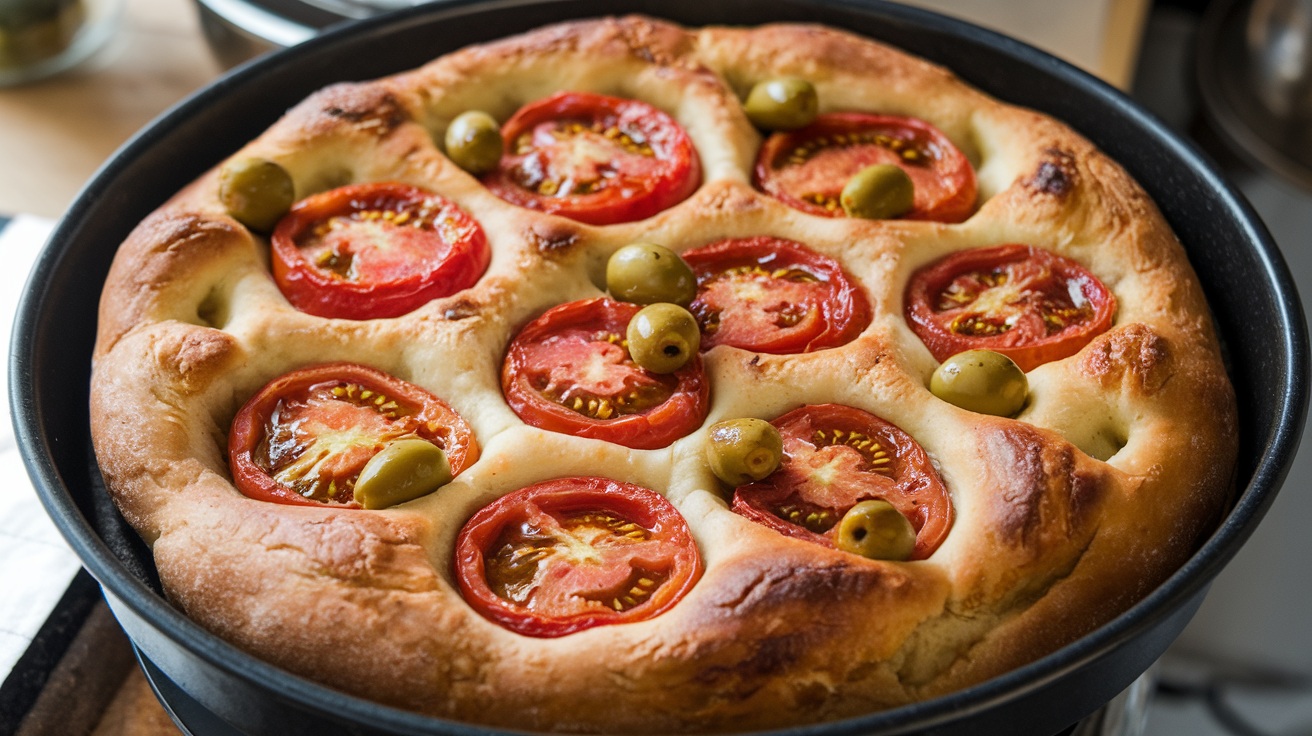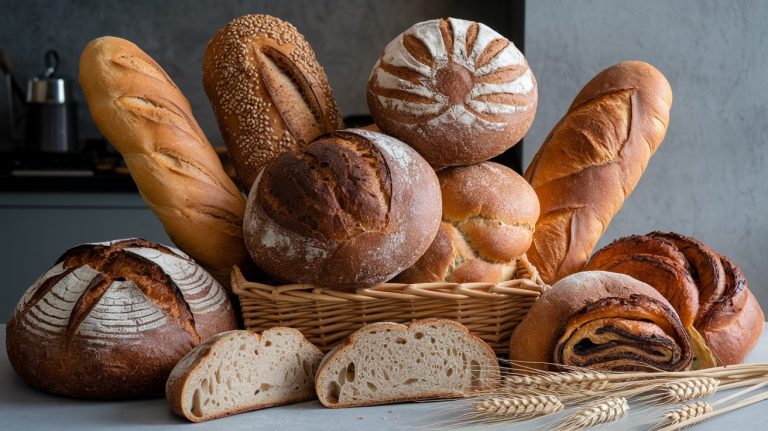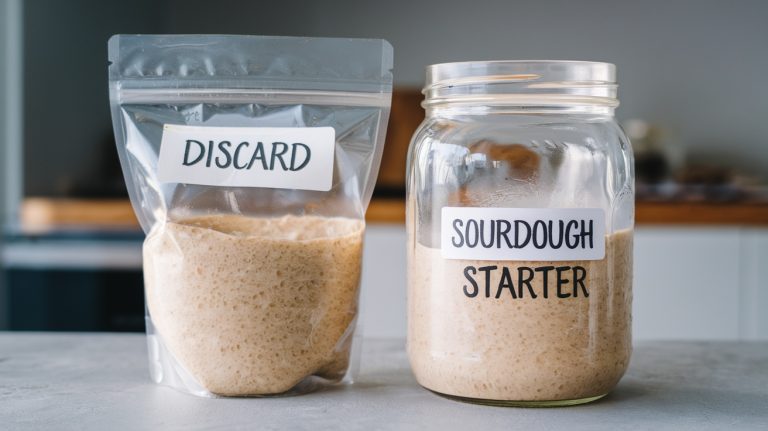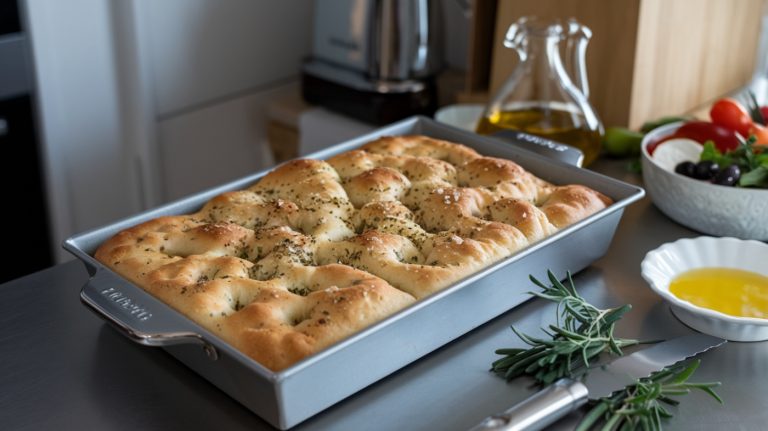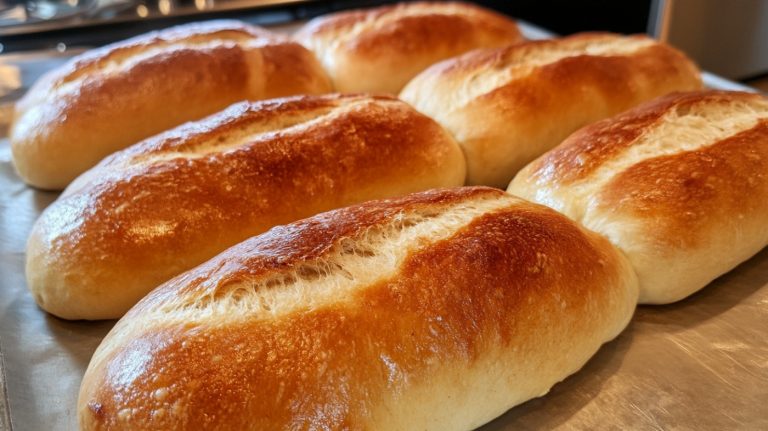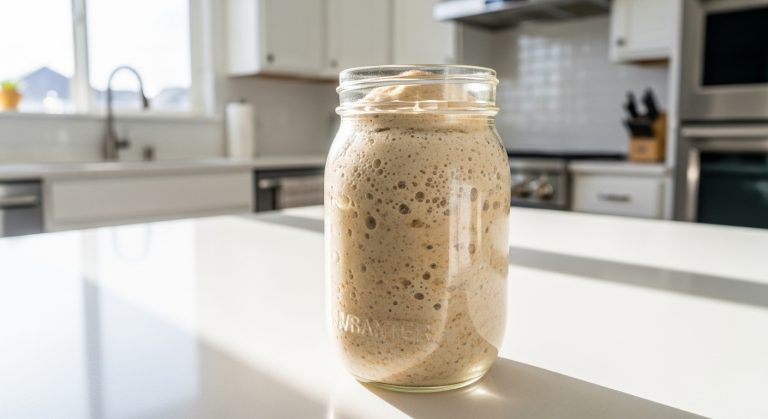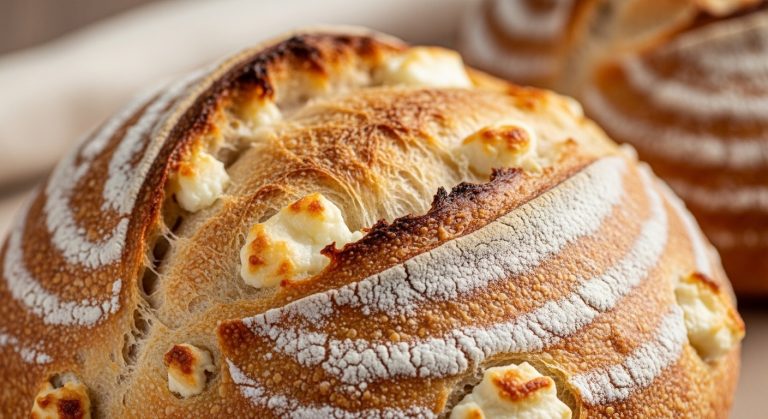Barese Focaccia Recipe: Classic Toppings and Golden Perfection
To make authentic Barese focaccia, start by mixing 300g of 00 flour and 200g of re-milled semolina flour with some yeast and salt. Add 150g of cooled mashed potatoes for extra moisture, then gradually mix in 400ml of warm water.
Knead until elastic, let it rise for a few hours, and stretch the dough into a greased pan. Top it with ripe cherry tomatoes, a sprinkle of oregano, and drizzle with high-quality olive oil.
Bake at a high temperature until golden brown. This mouthwatering focaccia pairs perfectly with soups, and there’s plenty more to explore to enhance your baking experience.
Key Takeaways
- Combine 300g of 00 flour, 200g of semolina flour, yeast, salt, and 150g of mashed potatoes for the dough.
- Knead the dough for 5 to 7 minutes, then let it rise for 2.5 to 3 hours in a warm place.
- Preheat the oven to 250°C (475°F) and prepare a steamy environment for baking.
- Bake focaccia for 15 minutes at high temperature, then reduce to 200°C (392°F) for 20-30 minutes.
- Serve warm with toppings like cherry tomatoes and olives or alongside soups for a complete meal.
Focaccia Barese Overview
Nestled in the heart of Bari, Puglia, focaccia barese is a delightful flatbread that captivates with its crispy crust and soft, chewy interior. This traditional flatbread has deep roots, dating back to ancient Roman times, and showcases the region’s rich culinary heritage.
You’ll find that focaccia barese often features a variety of toppings, including vibrant cherry tomatoes, briny olives, and fragrant oregano, each adding a burst of flavor to the experience.
What sets this flatbread apart is its unique texture, enhanced by the optional addition of mashed potatoes, which creates a moist, tender bite. The key ingredients, like 300g of 00 flour and 200g of remilled semolina flour, work harmoniously with high-quality extra virgin olive oil, ensuring a satisfying and authentic, delectable result.
Essential Ingredients
To create a truly authentic focaccia barese, you’ll need a handful of fundamental ingredients to achieve that signature texture and flavor.
Start with the dough, which requires 300g of 00 flour and 200g of re-milled semolina flour. This combination gives your focaccia that perfect chewy yet tender bite. A key ingredient is 150g of mashed potatoes, which infuses moisture and softness into the dough.
Next, you’ll want to hydrate your mixture properly, so 400ml of water is essential to activate the yeast and guarantee a light, airy bread.
Don’t forget high-quality extra virgin olive oil; it’s critical for enriching the flavor and creating a crispy crust. You’ll want to incorporate it into the dough and drizzle generously on top before baking.
For toppings, ripe cherry tomatoes are a must—250 to 500g will add vibrant freshness and sweetness.
Consider adding olives and oregano for extra depth. Finally, a splash of olive oil over the toppings enhances flavor and visual appeal.
Preparation Techniques
Creating a perfect focaccia starts with mastering the preparation techniques that bring the dough to life. Mix 300g of 00 flour and 200g of re-milled semolina flour with 2 teaspoons of dry active yeast and a pinch of salt in a large bowl. This dry mixture forms the base of your dough.
Gradually mix 150g of cooled mashed potatoes and 400ml of warm water until you achieve a smooth, pliable consistency. Preheating your cast iron skillet can enhance the crust’s texture and flavor, making this step essential for a successful bake with optimal baking tips.
Next, knead the dough for about 5 to 7 minutes until it’s elastic and silky. Now, let it rise in a warm place for 2.5 to 3 hours, allowing it to double in size.
Once it has risen, gently stretch the dough into a greased baking pan, ensuring it reaches the edges. Add toppings like ripe tomatoes, olives, oregano, and a drizzle of olive oil.
After a brief resting period of about 30 minutes, your focaccia is ready to bake.
Baking Instructions
To achieve the perfect Barese focaccia, preheat your oven to a sizzling 250°C (475°F) and let your iron pan heat for at least 30 minutes.

It’s important to create a steamy environment for ideal crust development, as steam plays a vital role in baking.
Once the dough is stretched in the pan and topped with your favorite ingredients, bake it at that high temperature for 15 minutes before reducing the heat to 200°C (392°F) for another 20-30 minutes.
Keep an eye on it until it turns golden brown, ensuring the internal temperature hits about 90°C (194°F) for the best results.
For more on how steam affects baking quality, check steam’s role.
Oven Temperature Settings
Achieving the perfect focaccia barese relies heavily on the right oven temperature settings. Preheating your oven to a maximum temperature of 280°C (or 220°C for alternative recipes) creates the ideal baking conditions for your focaccia.
When you bake the focaccia, aim for 30-35 minutes at 280°C, or 20-25 minutes at 220°C. You’ll know it’s ready when it develops a gorgeous golden brown color and a crispy texture that invites you to take that first bite. Using a Dutch oven for even heat distribution can enhance the baking process, guaranteeing that your focaccia crust turns out perfectly.
For an even more pronounced crust, place your baking pan on the lowest rack during the initial phase of baking. This technique helps create that delightful crunch you’re after.
If you find that the top isn’t sufficiently browned, don’t hesitate to turn on the broiler for just an additional minute at the end of baking—this can make a world of difference!
Additionally, check the internal temperature of the focaccia; it should reach about 90°C (194°F) for proper doneness.
Baking Time Recommendations
When you’re ready to bake your focaccia barese, timing is essential for achieving that perfect texture and flavor. Start by preheating your oven to 280°C (or 220°C for alternative recipes).
The baking time will vary, so keep a close eye on your creation. Bake at 280°C for 30-35 minutes, or 20-25 minutes at 220°C.
Keep monitoring your baking closely to guarantee your focaccia is fully cooked and reaches an internal temperature of about 90°C (194°F). If you notice the top isn’t brown and crispy enough, consider broiling it for a minute at the end to enhance the color.
Remember, several factors can influence your baking time:
- Thickness of the dough
- Type of baking pan used
- Oven temperature settings
- Desired level of doneness
- Monitoring baking closely
Serving Suggestions
When you serve warm Barese focaccia, consider pairing it with your favorite soup for a comforting meal that balances textures and flavors.
As a snack or appetizer, cut it into wedges for easy sharing at gatherings—its delightful taste is sure to impress your guests.
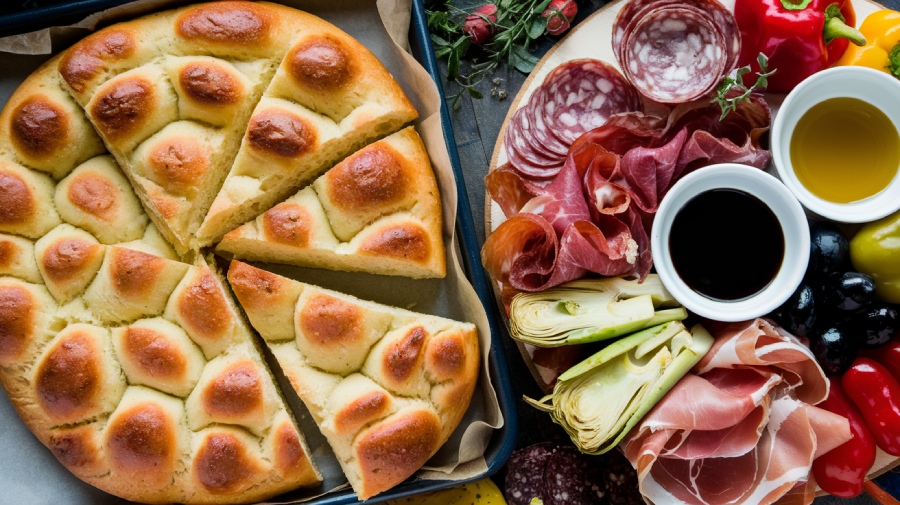
You can also enjoy it with a drizzle of olive oil or alongside an antipasto platter, creating a delicious start to any occasion.
Pairing With Soups
Pairing focaccia barese with soups brings a delightful synergy to your dining experience, as the bread’s crispy crust and chewy interior complement a variety of flavors.
Whether you’re indulging in a creamy tomato basil or a robust minestrone, focaccia enhances each bite, making your meal even more satisfying.
The combination of focaccia barese’s robust flavors—especially when topped with ripe tomatoes and black olives—pairs beautifully with hearty soups.
Its versatile nature allows it to be served warm or at room temperature, making it a fantastic choice for both hot and chilled soups.
The moist texture of the focaccia soaks up the soup’s essence, intensifying the overall taste.
When considering soup pairings, keep these in mind:
- Creamy potato leek for a rich contrast
- Hearty minestrone showcasing regional flavors
- Traditional ribollita for a rustic touch
- Tomato basil for a classic combo
- Chilled gazpacho for a revitalizing twist
Snack or Appetizer
Focaccia barese shines as an irresistible snack or appetizer, thanks to its vibrant toppings of cherry tomatoes and olives that elevate its charm. This delicious focaccia recipe is perfect for casual gatherings, whether you’re hosting a picnic or a lively party.
Warm or served at room temperature, it adapts beautifully to any occasion, inviting everyone to indulge. With its colorful and textured presentation, focaccia becomes a centerpiece that enhances the dining experience.
Cut into wedges, focaccia becomes the ultimate finger food, ideal for sharing this recipe with friends and family. Pair it with Italian cheeses or cured meats, and you’ll create a delightful contrast of flavors and textures that will impress your guests.
The flavorful toppings not only enhance the focaccia but also make it a standout appetizer that complements a variety of drinks.
In southern Italy, focaccia is often enjoyed alongside soups and salads, serving as a hearty side that adds depth to your meal.
Storage Tips
To keep your Barese focaccia fresh and delicious, proper storage is essential. This delightful bread, enriched with mashed potatoes for added moisture, can maintain its quality for about 2-3 days when stored correctly.
Here are some tips to guarantee you enjoy every bite:
- Wrap it well: Use plastic wrap or foil to keep the focaccia from drying out at room temperature.
- Cool completely: Let the focaccia cool entirely before slicing, enhancing its texture and flavor.
- Slice before freezing: If you want to store it longer, slice your focaccia into portions before freezing for up to 3 months.
- Watch the moisture: If you use canned tomatoes as a topping, make sure to drain them well to avoid excess moisture during storage.
- Room temperature is key: Keep your focaccia at room temperature for the best taste and texture within the first few days.
Frequently Asked Questions
What Are the Two Types of Focaccia?
When you think about focaccia, two main types stand out: Focaccia Genovese and Focaccia Barese.
Focaccia Genovese, hailing from Genoa, boasts a light, airy texture, often topped simply with olive oil and sea salt.
In contrast, Focaccia Barese, from Bari, features a dense, chewy interior, typically adorned with tomatoes, olives, and herbs.
Each variety showcases unique flavors and textures, making them beloved across different regions.
You’ll enjoy exploring their distinct characteristics!
What Is the Origin of Focaccia Barese?
Imagine walking through the sun-drenched streets of Bari, where the aroma of freshly baked bread fills the air.
Focaccia Barese traces its roots back to ancient Roman times, evolving through centuries in the heart of Puglia. This flatbread reflects the region’s rich culinary traditions, using simple ingredients like potatoes to create a uniquely moist texture and crispy crust.
It’s more than just food; it’s a delicious symbol of the local culture and history.
Which Flour Is Best for Focaccia?
When it comes to making focaccia, you should opt for 00 flour. Its fine texture and high protein content create a light, airy crumb that elevates your bread.
You can also mix in remilled semolina flour for a unique yellow hue and extra chewiness. Aim for a combination of 300g of 00 flour and 200g of semolina for the best results.
While all-purpose flour works in a pinch, it won’t quite match the desired texture.
Why Do You Poke Holes in Focaccia?
Poking holes in focaccia isn’t just a fun activity; it’s essential for achieving that perfect texture. When you press your fingertips into the dough, you create dimples that hold toppings like olive oil and herbs, enhancing flavor and moisture.
These holes allow steam to escape, preventing sogginess and promoting a crispy crust. Plus, they help distribute toppings evenly, ensuring every bite bursts with deliciousness.
Warm, Fluffy, and Glistening: The Ultimate Focaccia Barese Experience
You might think making Focaccia Barese is too complicated, but it’s actually quite simple and incredibly rewarding! With just a handful of fresh ingredients and a little patience, you can create a golden, aromatic bread that will impress your family and friends.
Imagine pulling a warm, fluffy loaf from the oven, its surface glistening with olive oil and topped with sun-dried tomatoes and olives. Once you taste it, you’ll see that this delicious journey is well worth the effort!

